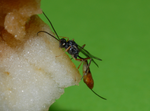
VISSER Bertanne
- Evolution and Ecophysiology lab - Earth and Life Institute, UCLouvain, Louvain-la-Neuve, Belgium
- Adaptation, Behavior & Social Evolution, Evolutionary Ecology, Genotype-Phenotype, Life History, Macroevolution, Molecular Evolution, Phenotypic Plasticity, Phylogenetics / Phylogenomics, Sexual Selection, Species interactions
- recommender
Recommendations: 2
Reviews: 0
Recommendations: 2

Relaxation of purifying selection suggests low effective population size in eusocial Hymenoptera and solitary pollinating bees
Multi-gene and lineage comparative assessment of the strength of selection in Hymenoptera
Recommended by Bertanne Visser based on reviews by Michael Lattorff and 1 anonymous reviewerGenetic variation is the raw material for selection to act upon and the amount of genetic variation present within a population is a pivotal determinant of a population’s evolutionary potential. A large effective population size, i.e., the ideal number of individuals experiencing the same amount of genetic drift and inbreeding as an actual population, Ne (Wright 1931, Crow 1954), thus increases the probability of long-term survival of a population. However, natural populations, as opposed to theoretical ones, rarely adhere to the requirements of an ideal panmictic population (Sjödin et al. 2005). A range of circumstances can reduce Ne, including the structuring of populations (through space and time, as well as age and developmental stages) and inbreeding (Charlesworth 2009). In mammals, species with a larger body mass (as a proxy for lower Ne) were found to have a higher rate of nonsynonymous nucleotide substitutions (that alter the amino acid sequence of a protein), as well as radical amino acid substitutions (altering the physicochemical properties of a protein) (Popadin et al. 2007). In general, low effective population sizes increase the chance of mutation accumulation and drift, while reducing the strength of selection (Sjödin et al. 2005).
In this paper, Weyna and Romiguier (2021) set out to test if parasitism, body size, geographic range, and/or eusociality affect the strength of selection in Hymenoptera. Hymenoptera include the bees, wasps and ants and is an extraordinarily diverse order within the insects. It was recently estimated that Hymenoptera is the most speciose order of the animal kingdom (Forbes et al. 2018). Hymenoptera are further characterized by an impressive radiation of parasitic species, mainly parasitoids, that feed in or on a single host individual to complete their own development (Godfray 1994). All hymenopterans share the same sex determination system: haplo-diploidy, where unfertilized eggs are haploid males and fertilized eggs are diploid females. Compared to other animals, Hymenoptera further contain an impressive number of clades that evolved eusociality (Rehan and Toth 2015), in which societies show a clear division of labor for reproduction (i.e., castes) and cooperative brood care. Hymenopterans thus represent a diverse and interesting group of insects to investigate potential factors affecting strength of selection and Ne.
Using a previously published phylogenomic dataset containing 3256 genes and 169 hymenopteran species (Peters et al. 2017), Weyna and Romiguier (2021) estimated mean genomic dN/dS ratios (nonsynonymous to synonymous substitution rates) for each species and compared these values between parasitic and non-parasitic species, eusocial and solitary species, and in relation to body size, parasitoid-specific traits and geographic range, thought to affect the effective population size and strength of selection. The use of a large number of species, as well as several distinct traits is a clear asset of this study. The authors found no effect of body size, geographic range or parasitism (including a range of parasitoid-specific traits). There was an effect, however, of eusociality where dN/dS increased in three out of four eusocial lineages. Future studies including more independent evolutionary transitions to eusociality can lend further support that eusocial species indeed reduces the efficiency of selection. The most intriguing result was that for solitary and social bees, with high dN/dS ratios and a strong signature of relaxed selection (i.e., the elimination or reduction of a source of selection (Lahti et al. 2009). The authors suggest that the pollen-collecting behaviors of these species can constrain Ne, as pollen availability varies at both a spatial and temporal scale, requiring a large investment in foraging that may in turn limit reproductive output. It would be interesting to see if other pollen feeders, such as certain beetles, flies, butterflies and moths, as well as mites and spiders, experience relaxed selection as a consequence of the trade-off between energy investment in pollen foraging versus fecundity.
References
Charlesworth, B. (2009). Effective population size and patterns of molecular evolution and variation. Nature Reviews Genetics, 10(3), 195-205. doi: https://doi.org/10.1038/nrg2526
Crow, J. F. (1954) Statistics and Mathematics in Biology (eds Kempthorne, O., Bancroft, T. A., Gowen, J. W. & Lush, J. L.) 543–556 (Iowa State Univ. Press, Ames, Iowa)
Forbes, A. A., Bagley, R. K., Beer, M. A., Hippee, A. C., and Widmayer, H. A. (2018). Quantifying the unquantifiable: why Hymenoptera, not Coleoptera, is the most speciose animal order. BMC ecology, 18(1), 1-11. doi: https://doi.org/10.1186/s12898-018-0176-x
Godfray, H. C. J. (1994) Parasitoids: Behavioral and Evolutionary Ecology. Vol. 67, Princeton University Press, 1994. doi: https://doi.org/10.2307/j.ctvs32rmp
Lahti et al. (2009). Relaxed selection in the wild. Trends in ecology & evolution, 24(9), 487-496. doi: https://doi.org/10.1016/j.tree.2009.03.010
Peters et al. (2017). Evolutionary history of the Hymenoptera. Current Biology, 27(7), 1013-1018. doi: https://doi.org/10.1016/j.cub.2017.01.027
Popadin, K., Polishchuk, L. V., Mamirova, L., Knorre, D., and Gunbin, K. (2007). Accumulation of slightly deleterious mutations in mitochondrial protein-coding genes of large versus small mammals. Proceedings of the National Academy of Sciences, 104(33), 13390-13395. doi: https://doi.org/10.1073/pnas.0701256104
Rehan, S. M., and Toth, A. L. (2015). Climbing the social ladder: the molecular evolution of sociality. Trends in ecology & evolution, 30(7), 426-433. doi: https://doi.org/10.1016/j.tree.2015.05.004
Sjödin, P., Kaj, I., Krone, S., Lascoux, M., and Nordborg, M. (2005). On the meaning and existence of an effective population size. Genetics, 169(2), 1061-1070. doi: https://doi.org/10.1534/genetics.104.026799
Weyna, A., and Romiguier, J. (2021) Relaxation of purifying selection suggests low effective population size in eusocial Hymenoptera and solitary pollinating bees. bioRxiv, 2020.04.14.038893, ver. 5 peer-reviewed and recommended by PCI Evol Biol. doi: https://doi.org/10.1101/2020.04.14.038893
Wright, S. (1931). Evolution in Mendelian populations. Genetics, 16(2), 97-159.

Insects and incest: sib-mating tolerance in natural populations of a parasitoid wasp
Incestuous insects in nature despite occasional fitness costs
Recommended by Caroline Nieberding and Bertanne Visser based on reviews by 2 anonymous reviewersInbreeding, or mating between relatives, generally lowers fitness [1]. Mating between genetically similar individuals can result in higher levels of homozygosity and consequently a higher frequency with which recessive disease alleles may be expressed within a population. Reduced fitness as a consequence of inbreeding, or inbreeding depression, can vary between individuals, sexes, populations and species [2], but remains a pervasive challenge for many organisms with small local population sizes, including humans [3]. But all is not lost for individuals within small populations, because an array of mechanisms can be employed to evade the negative effects of inbreeding [4], including sib-mating avoidance and dispersal [5, 6].
Despite thorough investigation of inbreeding and sib-mating avoidance in the laboratory, only very few studies have ventured into the field besides studies on vertebrates and eusocial insects. The study of Collet et al. [7] is a surprising exception, where the effect of male density and frequency of relatives on inbreeding avoidance was tested in the laboratory, after which robust field collections and microsatellite genotyping were used to infer relatedness and dispersal in natural populations. The parasitic wasp Venturia canescens is an excellent model system to study inbreeding, because mating success was previously found to decrease with increasing relatedness between mates in the laboratory [8] and this species thus suffers from inbreeding depression [9–11]. The authors used an elegant design combining population genetics and model simulations to estimate relatedness of mating partners in the field and compared that with a theoretical distribution of potential mate encounters when random mating is assumed. One of the most important findings of this study is that mating between siblings is not avoided in this species in the wild, despite negative fitness effects when inbreeding does occur. Similar findings were obtained for another insect species, the field cricket Gryllus campestris [12], which leaves us to wonder whether inbreeding tolerance could be more common in nature than currently appreciated.
The authors further looked into sex-specific dispersal patterns between two patches located a few hundred meters apart. Females were indeed shown to be more related within a patch, but no genetic differences were observed between males, suggesting that V. canescens males more readily disperse. Moreover, microsatellite data at 18 different loci did not reveal genetic differentiation between populations approximately 300 kilometers apart. Gene flow is thus occurring over considerable distances, which could play an important role in the ability of this species to avoid negative fitness consequences of inbreeding in nature.
Another interesting aspect of this work is that discrepancies were found between laboratory- and field-based data. What is the relevance of laboratory-based experiments if they cannot predict what is happening in the wild? Many, if not most, biologists (including us) bring our model system into the laboratory to control, at least to some extent, the plethora of environmental factors that could potentially affect our system (in ways that we do not want). Most behavioral studies on mating patterns and sexual selection are conducted in standardized laboratory conditions, but sexual selection is in essence social selection, because an individual’s fitness is partly determined by the phenotype of its social partners (i.e. the social environment) [13]. The social environment may actually dictate the expression of female mate choice and it is unclear how potential laboratory-induced social biases affect mating outcome. In V. canescens, findings using field-caught individuals paint a completely opposite picture of what was previously shown in the laboratory, i.e. sib-avoidance is not taking place in the field. It is likely that density, level of relatedness, sex ratio in the field, and/or the size of experimental arenas in the lab are all factors affecting mate selectivity, as we have previously shown in a butterfly [14–16]. If females, for example, typically only encounter a few males in sequence in the wild, it may be problematic for them to express choosiness when confronted simultaneously with two or more males in the laboratory. A recent study showed that, in the wild, female moths take advantage of staying in groups to blur male choosiness [17]. It is becoming more and more clear that what we observe in the laboratory may not actually reflect what is happening in nature [18]. Instead of ignoring the species-specific life history and ecological features of our favorite species when conducting lab experiments, we suggest that it is time to accept that we now have the theoretical foundations to tease apart what in this “environmental noise” actually shapes sexual selection in nature. Explicitly including ecology in studies on sexual selection will allow us to make more meaningful conclusions, i.e. rather than “this is what may happen in the wild”, we would be able to state “this is what often happens in nature”.
References
[1] Charlesworth D & Willis JH. 2009. The genetics of inbreeding depression. Nat. Rev. Genet. 10: 783–796. doi: 10.1038/nrg2664
[2] Hedrick PW & Garcia-dorado A. 2016. Understanding inbreeding depression, purging, and genetic rescue. Trends Ecol. Evol. 31: 940–952. doi: 10.1016/j.tree.2016.09.005
[3] Bittles AH & Black ML. 2010. Consanguinity, human evolution, and complex diseases. Proc. Natl. Acad. Sci. United States Am. 107: 1779–1786. doi: 10.1073/pnas.0906079106
[4] Pusey A & Wolf M. 1996. Inbreeding avoidance in animals. Trends Ecol. Evol. 11: 201–206. doi: 10.1016/0169-5347(96)10028-8
[5] Greenwood PJ & Harvey PH. 1978. Inbreeding and dispersal in the great tit. Nature 271: 52–54. doi: 10.1038/271052a0
[6] Szulkin M & Sheldon BC. 2008. Dispersal as a means of inbreeding avoidance in a wild bird population. Proc. R. Soc. B 275: 703–711. doi: 10.1098/rspb.2007.0989
[7] Collet M, Amat I, Sauzet S, Auguste A, Fauvergue X, Mouton L, Desouhant E. 2018. Insects and incest: sib-mating tolerance in natural populations of a parasitoid wasp. bioRxiv 169268, ver. 4 peer-reviewed by Peer Community In Evolutionary Biology. doi: 10.1101/169268
[8] Metzger M, Bernstein C, Hoffmeister TS & Desouhant E. 2010. Does kin recognition and sib-mating avoidance limit the risk of genetic incompatibility in a parasitic wasp ? PLoS One 5: e13505. doi: 10.1371/journal.pone.0013505
[9] Beukeboom LW. 2001. Single-locus complementary sex determination in the Ichneumonid Venturia canescens. Netherlands J. Zool. 51: 1–15. doi: 10.1163/156854201X00017
[10] Vayssade C, de Fazio C, Quaglietti B, Auguste A, Ris N, Fauvergue X. 2014. Inbreeding depression in a parasitoid wasp with single- locus complementary sex determination. PLoS One 9: 1–8. doi: 10.1371/journal.pone.0097733
[11] Chuine A, Sauzet S, Debias F & Desouhant E. 2015. Consequences of genetic incompatibility on fitness and mate choice: the male point of view. Biol. J. Linn. Soc. 114: 279–286. doi: 10.1111/bij.12421
[12] Bretman A, Rodri R & Tregenza T. 2011. Fine-scale population structure , inbreeding risk and avoidance in a wild insect population. Mol. Ecol. 20: 3045–3055. doi: 10.1111/j.1365-294X.2011.05140.x
[13] West-Eberhard MJ. 2014. Darwin’s forgotten idea: The social essence of sexual selection. Neurosci. Biobehav. Rev. 46: 501–508. doi: 10.1016/j.neubiorev.2014.06.015
[14] Holveck M-J, Gauthier A-L & Nieberding CM 2015. Dense, small and male-biased cages exacerbate male-male competition and reduce female choosiness in Bicyclus anynana. Anim. Behav. 104: 229–245. doi: 10.1016/j.anbehav.2015.03.025
[15] Nieberding, CM & Holveck M-J 2017. Laboratory social environment biases mating outcome: a first quantitative synthesis in a butterfly. Behav. Ecol. Sociobiol. 71: 117. doi: 10.1007/s00265-017-2346-9
[16] Nieberding CM & Holveck M-J. (In prep). Comentary on Kehl et al. 2018: "Young male mating success is associated with sperm number but not with male sex pheromone titres". Front. Ecol. Evol.
[17] Wijk M Van, Heath J, Lievers R, Schal C & Groot AT. 2017. Proximity of signallers can maintain sexual signal variation under stabilizing selection. Sci. Rep. 7: 18101. doi: 10.1038/s41598-017-17327-9
[18] Miller CW & Svensson EI. 2014. Sexual selection in complex environments. Annu. Rev. Entomol. 59: 427–445. doi: 10.1146/annurev-ento-011613-162044